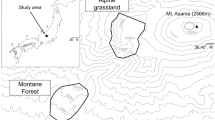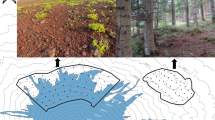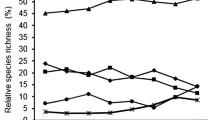Summary
Resource partitioning of diet and habitat use was studied in the entire Amazonian ungulate community of Northeastern Peru, which comprises the red brocket deer (Mazama americana), grey brocket deer (M. gouazoubira), collared peccary (Tayassu tajacu), white-lipped peccary (T. pecari), and lowland tapir (Tapirus terrestris). Each ungulate species partitioned at least one type of resource from every other species. Digestive morphology had a greater influence on resource partitioning of diet than body size. Neither digestive morphology nor body size were related to segregation of habitats. However, species with similar diets partitioned habitats, whereas species with different diets often used the same type of forest. Increases in habitat breadth of ungulates were positively correlated with increases in dietary breadth.
Similar content being viewed by others
References
Bell RHV (1971) A grazing ecosystem in the Serengeti. Sci Amer 255: 86–93
Bodmer RE, Fang TG, Moya L (1988) Ungulate management and conservation in the Peruvian Amazon. Biol Conserv 45: 303–310
Brown JH (1987) Variation of desert rodent guilds: patterns, processes, and scales. In: Gee JHR, Giller PS (eds) Organization of Communities: Past and Present. Blackwell Scientific Publications Oxford
Chivers DJ, Hladik CM (1980) Morphology of the gastrointestinal tract in primates: comparisons with other mammals in relation to diet. J Morphol 166: 337–386
Clutton-Brock TH, Harvey PH (1983) The functional significance of variation in body size among mammals. Spec Publ Amer Soc Mammal 7: 632–663
Connell JH (1975) Some mechanisms producing structure in natural communities: a model and evidence from field experiments. In: Cody MI, Diamond JM (eds) Ecology and Evolution of Communities. Harvard University Press, Cambridge, Massachusetts
Demment MW, Van Soest PJ (1985) A nutritional explanation for body-size patterns of ruminant and nonruminant herbivores. Am Nat 125: 641–672
Diamond J (1986) Evolution and ecological segregation in the New Guinea montane avifauna. In: Diamond JM, Case TJ (eds) Community Ecology. Harper and Row, New York
Digby PGN, Kempton RA (1987) Multivariate Analysis of Ecological Communities. Chapman and Hall, London
Dubost G (1984) Comparison of the diets of frugivorous forest ruminants of Gabon. J Mammal 65: 298–316
Dunbar RIM (1978) Competition and niche separation in a high altitude herbivore community in Ethiopia. E Afr Wildl J 16: 183–199
Feinsinger P, Spears E, Poole RW (1981) A simple measure of niche breadth. Ecology 62: 27–32
Gordon IJ, Illius AW (1988) Incisor arcade structure and diet selection in ruminants. Functional Ecology 2: 15–22
Hair JD (1980) Measurement of ecological diversity. In: Schemnitz SD (ed) Wildlife Management Techniques Manual 4th edition. The Wildlife Society Inc, Washington DC
Hassell MP (1978) The Dynamics of Arthropod Predator-Prey Systems. Princeton University Press, Princeton
Hofmann RR (1973) The Ruminant Stomach: Stomach Structure and Feeding Habits of East African Game Ruminants. Kenya Literature Bureau. Nairobi
Jarman PJ (1974) The social organization of antelope in relation to their ecology. Behaviour 48: 215–266
Jenkins KJ, Wright RG (1988) Resource partitioning and competition among Cervids in the northern Rocky Mountains. J Appl Ecol 25: 11–24
Lamprey HF (1963) Ecological separation of the large mammal species in the Tarangire Game Reserve, Tanganyika. E Afr Wildl J 1: 63–92
MacArthur RH (1972) Geographical Ecology: Patterns in the Distribution of Species. Princeton Univ Press, Princeton
Parra R (1978) Comparison of foregut and hindgut fermentation in herbivores. In: Montgomery GG (ed) The Ecology of Arboreal Folivores. Smithsonian Institution Press, Washington DC
Pianka ER (1976) Competition and niche theory. In: May RM (ed) Theoretical Ecology. Blackwell Scientific Publications, Oxford
Roosmalen MGM van (1985) Fruits of the Guianan Flora. Institute of Systematic Botany, Utrecht University, Netherlands
Schoener TW (1968) The Anolis lizards of Bimqini: resource partitioning in a complex fauna. Ecology 49: 704–726
Schoener TW (1986) Resource partitioning. In: Kikkawa J, Anderson DJ (eds) Community Ecology: Pattern and Process. Blackwell Scientific Publications, Oxford
Schwartz CC, Ellis JE (1981) Feeding ecology and niche separation in some native and domestic ungulates on the shortgrass prairie. J Appl Ecol 18: 343–353
Shannon CE, Weaver W (1949) The Mathematical Theory of Communication. University of Illinois Press, Urbana
Stevens CE (1988) Comparative Physiology of the Vertebrate Digestive System. Cambridge University Press, Cambridge
Strong DR (1984) Exorcising the ghost of competition past: phytophagous insects. In: Strong DR, Simberloff D, Abele LG, Thistle AB (eds) Ecological Communities: Conceptual Issues and the Evidence. Princeton University Press, Princeton
Terborgh J (1983) Five New World Primates: A Study in Comparative Ecology. Princeton University Press, Princeton
Van Soest PJ (1982) Nutritional Ecology of the Ruminant. O and B Books Inc, Corvallis, Oregon
Author information
Authors and Affiliations
Rights and permissions
About this article
Cite this article
Bodmer, R.E. Influence of digestive morphology on resource partitioning in Amazonian ungulates. Oecologia 85, 361–365 (1991). https://doi.org/10.1007/BF00320611
Received:
Accepted:
Issue Date:
DOI: https://doi.org/10.1007/BF00320611




